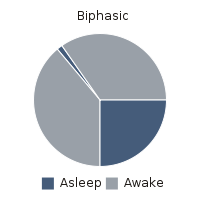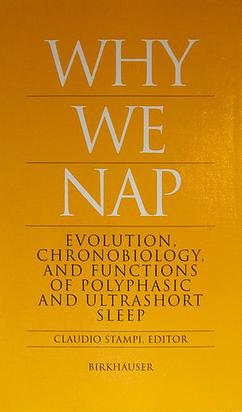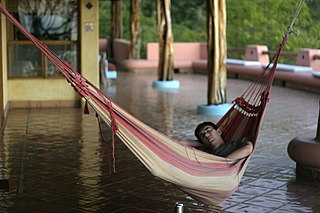Historical use

One classic cultural example of a biphasic sleep pattern is the practice of siesta, which is a nap taken in the early afternoon, often after the midday meal. Such a period of sleep is a common tradition in some countries, particularly those where the weather is warm. The siesta is historically common throughout the Mediterranean and Southern Europe. It is the traditional daytime sleep of China, [6] India, South Africa, Italy, [7] Greece, Spain and, through Spanish influence, the Philippines and many Hispanic American countries.[ citation needed ]
A separate biphasic sleep pattern is sometimes described as segmented sleep, often consisting of going to sleep early at night, awakening in the post-midnight hours, and then returning to bed for a second period of sleep into the morning. In a New York Times article, author Jesse Barron asserts that this practice was common in the past: "in the preindustrial West, most people slept in two discrete blocks." [8] Benjamin Franklin was a prominent example of this sleeping pattern. [8] Interrupted sleep is a primarily biphasic sleep pattern where two periods of nighttime sleep are punctuated by a period of wakefulness. Along with a nap in the day, it has been argued that this is the natural pattern of human sleep in long winter nights. [9] [10] A case has been made that maintaining such a sleep pattern may be important in regulating stress. [10]
A belief in the need for biphasic sleeping as essential to the health of children is mentioned in a letter in the seminal nineteenth-century text Street Music in the Metropolis: Correspondence and Observations on the Existing Law, and Proposed Amendments: "With children to whom it is essential that they should have sleep twice a day, being very young, street music is a great nuisance." [11]

Buckminster Fuller described a regimen consisting of 30-minute naps every six hours. The short article about Fuller's nap schedule in Time in 1943, which referred to the schedule as "intermittent sleeping", says that he maintained it for two years, and notes that "he had to quit because his schedule conflicted with that of his business associates, who insisted on sleeping like other men." [12]
Ekirch's analysis of biphasic sleep in the pre-industrial era
Historian A. Roger Ekirch [13] [14] has argued that before the Industrial Revolution, interrupted sleep was dominant in Western civilization. He draws evidence from more than 500 references to a segmented sleeping pattern in documents from the ancient, medieval, and modern world. [10] Other historians, such as Craig Koslofsky, [15] have endorsed Ekirch's analysis.
According to Ekirch's argument, adults typically slept in two distinct phases, bridged by an intervening period of wakefulness of approximately one hour. [14] This time was used to pray [16] and reflect, [17] and to interpret dreams, which were more vivid at that hour than upon waking in the morning. This was also a favourite time for scholars and poets to write uninterrupted, whereas still others visited neighbours, engaged in sexual activity, or committed petty crime. [14] : 311–323
The human circadian rhythm regulates the human sleep-wake cycle of wakefulness during the day and sleep at night. Ekirch suggests that it is due to the modern use of electric lighting that most modern humans do not practice interrupted sleep, which is a concern for some writers. [18] Superimposed on this basic rhythm is a secondary one of light sleep in the early afternoon. The brain exhibits high levels of the pituitary hormone prolactin during the period of nighttime wakefulness, which may contribute to the feeling of peace that many people associate with it. [19]
Ekirch has found that the two periods of night sleep were called "first sleep" (occasionally "dead sleep") and "second sleep" (or "morning sleep") in medieval England. He found that first and second sleep were also the terms in the Romance languages, as well as in the language of the Tiv of Nigeria. In French, the common term was premier sommeil or premier somme; in Italian, primo sonno; in Latin, primo somno or concubia nocte. [14] : 301–302 He found no common word in English for the period of wakefulness between, apart from paraphrases such as first waking or when one wakes from his first sleep and the generic watch in its old meaning of being awake. In Old French an equivalent generic term is dorveille , a portmanteau of the French words dormir (to sleep) and veiller (to be awake).
Because members of modern industrialised societies, with later evening hours facilitated by electric lighting, mostly do not practice interrupted sleep, Ekirch suggests that they may have misinterpreted and mistranslated references to it in literature. Common modern interpretations of the term first sleep are "beauty sleep" and "early slumber". A reference to first sleep in the Odyssey was translated as "first sleep" in the 17th century, but according to Ekirch, was commonly mistranslated in the 20th. [14] : 303
Ekirch's research into the commonality of biphasic sleep in the preindustrial West has led some to conclude he believes that the human body has a "natural preference for segmented sleep." [10] However, when directly asked if he espoused the idea that biphasic sleep was preferable, he responded "Not at all. At no time in history have conditions for human slumber been better than today. If the purpose of sleep is mental and physical well-being, there is very good reason to believe that uninterrupted sleep at night best achieves that outcome." [20]









